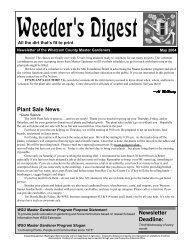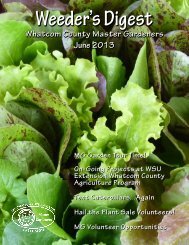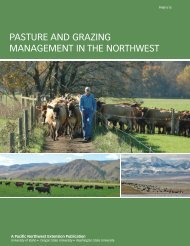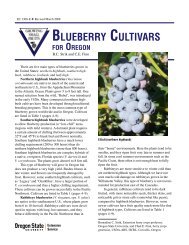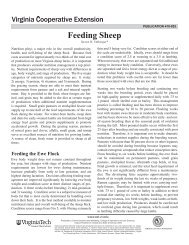Where Does Whatcom County Get its Food? - WSU Whatcom ...
Where Does Whatcom County Get its Food? - WSU Whatcom ...
Where Does Whatcom County Get its Food? - WSU Whatcom ...
You also want an ePaper? Increase the reach of your titles
YUMPU automatically turns print PDFs into web optimized ePapers that Google loves.
Farm-to-School<br />
• <strong>Food</strong> service providers at institutions struggle to get the best products for consumers at the lowest<br />
price; many count purchasing from local farms as a benefit to their missions but often cannot justify it<br />
financially.<br />
• Institutional food service providers cite several challenges to working with local food:<br />
- Lack of facilities for processing.<br />
- Delivery capacity of local farms.<br />
- Seasonal availability of produce.<br />
- <strong>Food</strong> safety liability.<br />
• Of positive note is the work that schools throughout the <strong>County</strong> have done to increase their local food<br />
purchasing from farm cooperatives and their food recycling through composting services.<br />
The Emergency <strong>Food</strong> System<br />
• The number of client vis<strong>its</strong> to <strong>Whatcom</strong> <strong>County</strong> food banks rose by 39% from 2007 to 2009. 35% of<br />
Bellingham <strong>Food</strong> Bank clients are children, and 16% are seniors.<br />
• Emergency food programs are increasing efforts to provide food from <strong>Whatcom</strong> <strong>County</strong> sources in order<br />
to be more self-supporting and to increase the freshness and health of the food distributed. Such<br />
initiatives include gleaning from local farms, supporting the training of new farmers interested in<br />
helping those in need, and actually growing food that will go directly to clients.<br />
• An increasing number of individuals in <strong>Whatcom</strong> <strong>County</strong> are using community gardens and the<br />
opportunity to grow their own food.<br />
Information about food sales, farm marketing trends, the emergency food system, and efforts to increase our<br />
community’s food self-sufficiency gives us a lot to go on when we look at areas in which our local food system is<br />
improving as well as opportunities that exist to make it stronger. The vast number of ways in which farms can sell<br />
products directly makes it very difficult for researchers to track exactly which methods work best. Each farm is<br />
different and what works for one may not work for another.<br />
A great deal of further development is possible with regard to farms filling the increasing institutional demand for<br />
locally produced food. Initial successes have been seen with smaller farms joining together to supply large<br />
quantities of products to institutions, which allows more <strong>Whatcom</strong> <strong>County</strong> residents to eat locally produced food.<br />
Significant opportunity for innovation within this sector calls for further study and for the creation or re-focusing<br />
of existing agricultural businesses.<br />
<strong>Food</strong> access is a significant challenge for many individuals and families in <strong>Whatcom</strong> <strong>County</strong>, based both upon<br />
geographic location and poverty. Maps created to show access to food stores throughout <strong>Whatcom</strong> <strong>County</strong><br />
provide the basis for continued study into which geographic regions of the <strong>County</strong> are in need of the greatest<br />
support for accessing healthy food. This baseline data suggests areas of opportunity for food businesses and for<br />
transportation planners who look at the overall geographic dispersal of a population and the satisfaction of basic<br />
needs for those elements of the population that are nutritionally disadvantaged. Of particular note are the<br />
regions of eastern <strong>Whatcom</strong> <strong>County</strong>, which have both transportation challenges and some of the highest levels of<br />
poverty.<br />
A great deal of opportunity exists for grassroots collaboration among organizations and individuals working with<br />
the emerging home and community garden movement. As efforts to develop community gardens, emergency<br />
39




